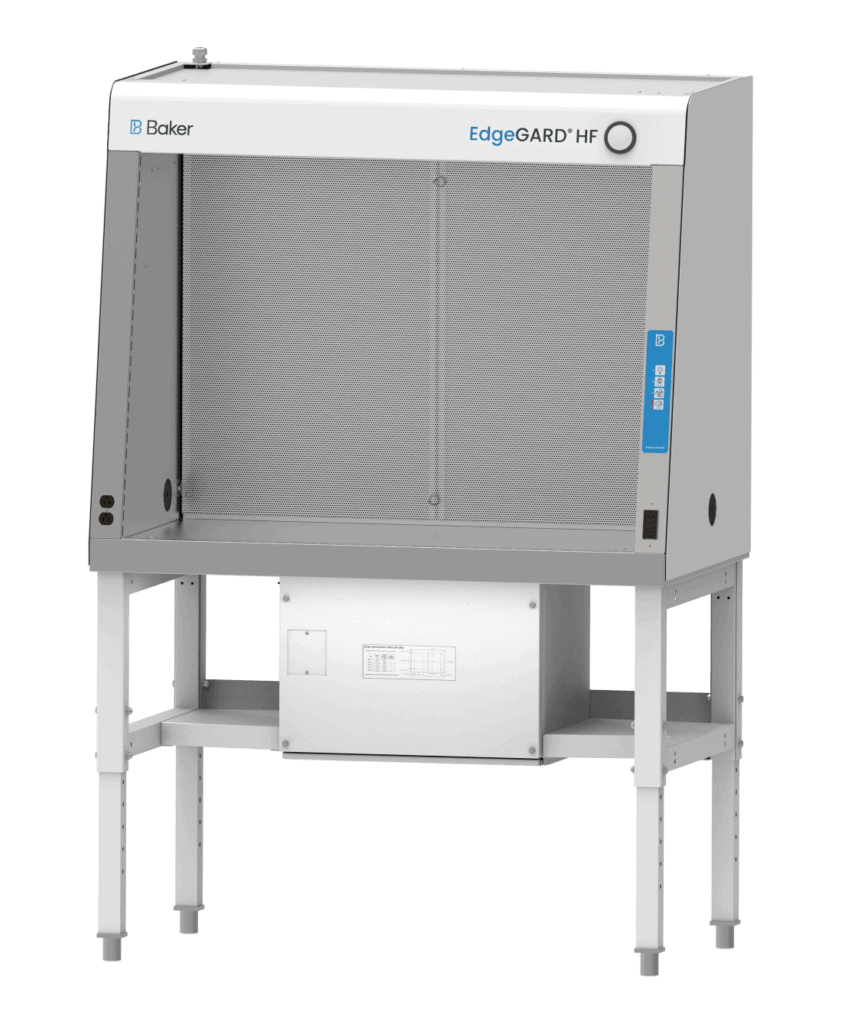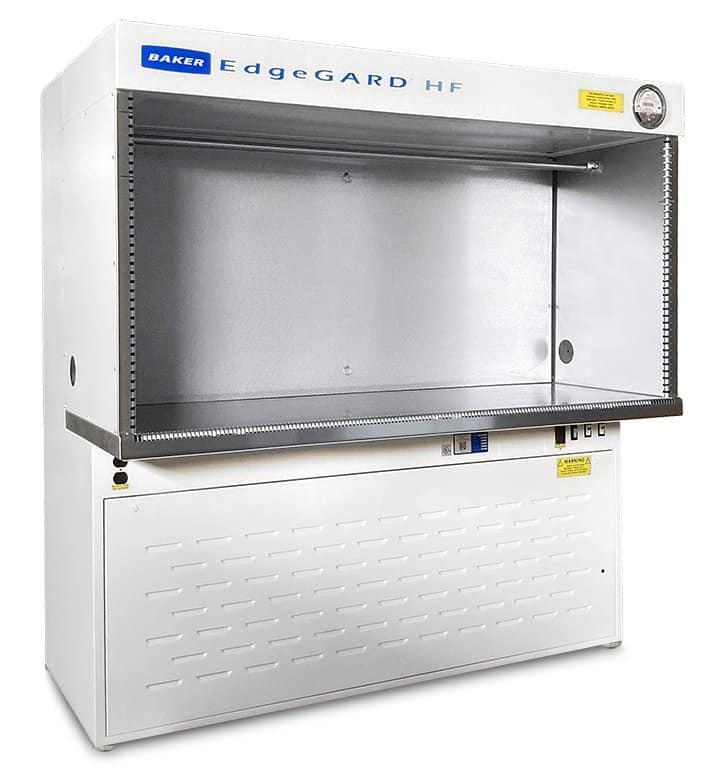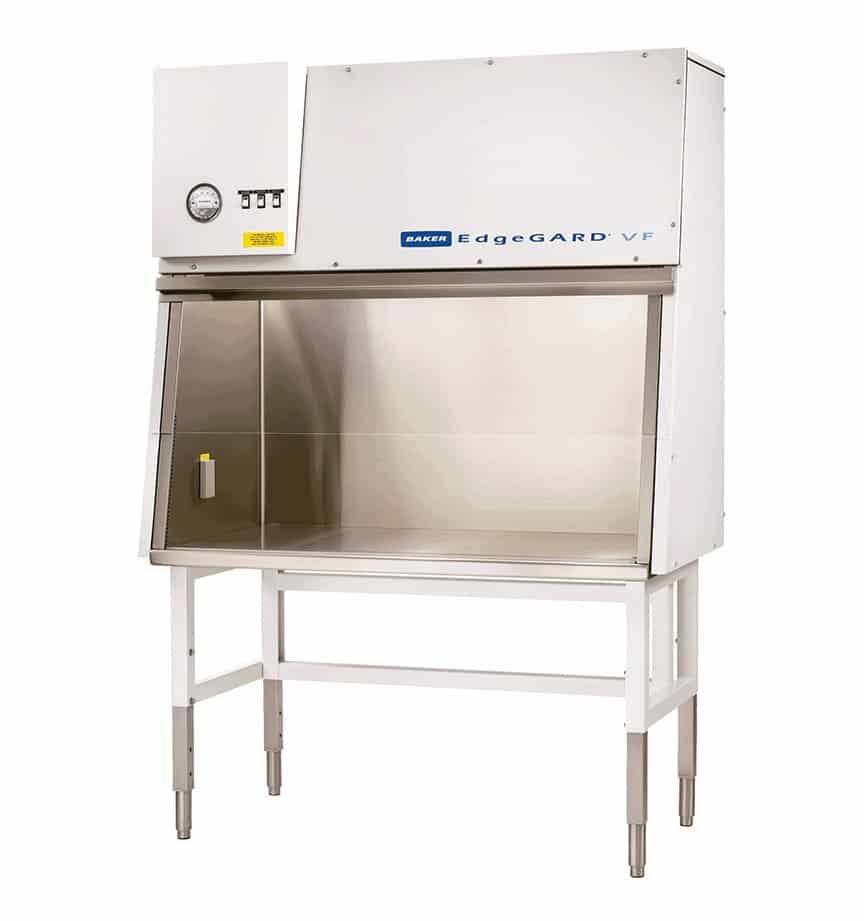
Laminar Flow Hoods
Horizontal and vertical models that provide protection for samples and work procedures.
The EdgeGARD® from Baker comes in several horizontal and vertical flow models that provide particulate-free, HEPA-filtered uniform airflow across the work area.
A laminar flow hood (clean bench) protects products and samples for a variety of life science, industrial laboratory and process applications. There are two categories of laminar flow hoods, horizontal and vertical, which refer to the direction of airflow within the hood.
-
 EdgeGARD® e3 HF Horizontal Flow Clean BenchThe EdgeGARD® e3 HF clean bench with a brightly illuminated, spacious work area and unique high-velocity air return slo …View Products
EdgeGARD® e3 HF Horizontal Flow Clean BenchThe EdgeGARD® e3 HF clean bench with a brightly illuminated, spacious work area and unique high-velocity air return slo …View Products -
 EdgeGARD HF Laminar Flow HoodsThe EdgeGARD HF clean bench provides HEPA filtered vertical laminar airflow. This hood offers best-in-class protection f …View Products
EdgeGARD HF Laminar Flow HoodsThe EdgeGARD HF clean bench provides HEPA filtered vertical laminar airflow. This hood offers best-in-class protection f …View Products -
 EdgeGARD VF Laminar Flow HoodsThe EdgeGARD VF clean bench provides HEPA filtered vertical laminar airflow. This hood offers best-in-class protection f …View Products
EdgeGARD VF Laminar Flow HoodsThe EdgeGARD VF clean bench provides HEPA filtered vertical laminar airflow. This hood offers best-in-class protection f …View Products -
 PCR WorkstationThe Benchmark SureAir™ PCR workstation is a compact, convenient way to reduce contamination concerns and provide a cle …View Products
PCR WorkstationThe Benchmark SureAir™ PCR workstation is a compact, convenient way to reduce contamination concerns and provide a cle …View Products
Horizontal Laminar Flow Hoods
These are designed for a variety of industry applications involving low-risk agents, including: sterile product preparation, sterile drug compounding, IV admixture preparation, plant cell culture, media preparation, pharmaceutical procedures, electronic assembly, limited experimental research.
Vertical Laminar Flow Hoods
Ideal for when product protection and some particulate control are required. Unlike a horizontal hood, these models provide controlled airflow in a vertical direction over the entire work surface. These are also designed for the same variety of industry applications as horizontal laminar flow hoods listed above.
Laminar Flow Hood Considerations
- Size: Our horizontal laminar flow hood models have a work surface height of 30”. Riser or caster options can be purchased to allow for work surface heights ranging from 36” to 42”. We even offer a space saver model for when you have a limited area, such as IV and nursing stations, satellite pharmacies, and intensive care units. Our vertical laminar flow hood models include an optional adjustable height stand that provides a work surface height range of 30” to 36”.
- Optional hydraulic lift: Baker also has the option of adding a hydraulic lift to both the horizontal and vertical flow clean benches. This option provides the most ergonomic solution for customers looking for work surface height adjustability.
- Placement and location: If floor space is tight, consider a vertical hood, which isn’t as deep.
- HEPA filtration: EdgeGARD models use a HEPA supply filter with 99.99% minimum efficiency in capturing 0.3 micrometer particulates. You can also easily remove the HEPA filter screen for cleaning or service, and a concealed HEPA filter frame eliminates turbulence at the rear wall.
- Ergonomics: All horizontal and vertical models feature cable ports, which allow a safe and ergonomic way of introducing cables and siphoning tubes into the hood without interfering with containment. The vertical flow models have an ergonomically designed sash that provides a 10-degree sloped angle.
- ISO classes: All of our models comply with standards from the International Organization for Standardization (ISO), which provides classifications for cleanrooms and the air inside them. Our horizontal models ensure ISO Class 5 (Class 100) cleanliness and our vertical units ensure ISO Class 4 (Class 10).
Common Laminar Flow Hood Applications
Horizontal and vertical laminar flow clean benches are designed for a variety of industry applications.
- Microscopy Flow Hood: When a microscope is being used in a laminar flow hood, you should consider vibration that might be caused by the motors. Using a vibration pad may help. If not, ask your sales rep if there is an option to isolate the motors. With this option, the motors are not mounted to the frame of the hood.
- PCR Hood: When clean air is needed for PCR experiments, a laminar flow hood is the perfect choice. These hoods are designed to protect equipment and other contents in the work area from particulates. Keep in mind, though, that this should just be used when product protection is required. If you need both product and personnel protection, you need a biological safety cabinet.
- Wet Processing Flow Hood: This is a specialized application that might require sinks and even polypropylene construction instead of metal. This application is something you should discuss with your local sales rep to review all the options.
- Cell Culture and Mycology Flow Hood: Typical cell culture done in a laminar flow hood is work that is not harmful to the lab technician, such as work on plants and fungi. These hoods provide the perfect clean air environment that is required of this type of work.
- Sterile Drug Compounding Cleanroom Hood: Laminar flow hoods have long been the workhorse of a pharmacy. They provide the particulate-free environment that is required. Common options include IV bar, storage bins and cable ports. Talk to your local sales rep to make sure you know about all available options.





